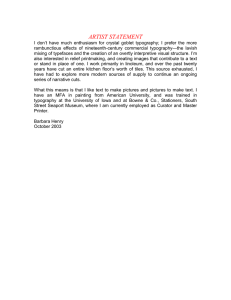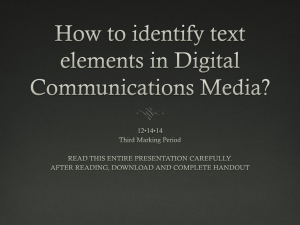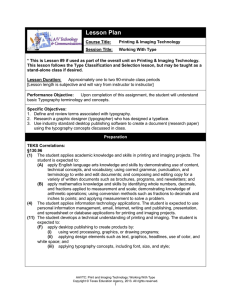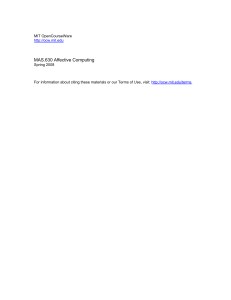Cool colors - UMM Directory
advertisement
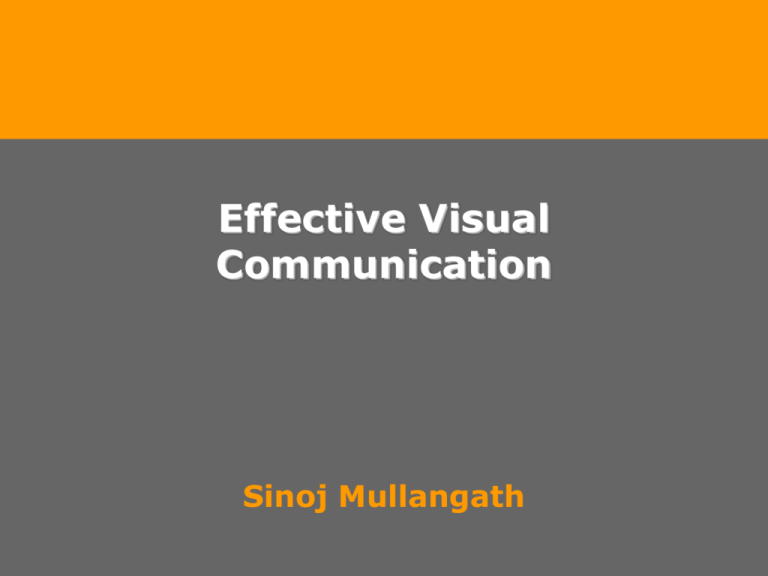
Effective Visual Communication Sinoj Mullangath Komunikasi • Komunikasi menyampaikan “fakta, konsep dan emosi” • Untuk menyampaikan sesuatu, diperlukan bahasa dan media • Bahasa memerlukan huruf, kata, kalimat dan aturan pemakaian (tata bahasa) Visual Media • Print Articles, Brochure, Manuals, Fine Arts • Motion Films, Animations, Performances • Interactive Websites, Online Help, CBTs, CD-ROM Visible Language • • • • • • • • • Layout Typography Color Texture Imagery Identity Sequencing Animation Sound Arts versus Design • Arts is a form of expression • Design is a form of communication Communication & Design • Design* is creating an interface that communicates the objective appropriately and clearly in that medium Medium Objective Appropriateness Clarity * In this context Interface Design Principles • To Organize: provide the user with a clear and consistent conceptual structure with grouping and hierarchy • To Economize: do the most with the least amount of cues • To Communicate: match the presentation to the capabilities of user perception Organize • Consistency Internal: same types of elements are shown in the same places External: existing platforms and cultural conventions should be followed across user interfaces Real world: consistent with real-world experiences, observations and perceptions of the user Innovation: deviating from existing conventions, if it provides a clear benefit to the user Organize • Screen Layout Use a grid structure • Define spaces • Spread vs. Page Design Standardize the structure • Easy to locate menus or dialogue boxes Group related elements Organize • Navigation provide an initial focus for the viewer's attention direct attention to primary, secondary, and peripheral items assist in navigation through the material simple learning curve Economize • Four major points to be considered Simplicity: include only the elements that are most important for communication Clarity: meaning of the components are not ambiguous Distinctiveness: important properties of the elements are distinct Emphasis: important elements are easily perceived Communicate • To communicate successfully, the interface must keep in balance: Legibility Readability Symbolism Multiple views Typography Color Legibility & Readability • Easily noticeable and distinguishable elements Legible Typefaces Desktop Icons Control Panel Symbols Background Colors Usage Environment • Comprehensible display Easy to identify and interpret Inviting and attractive Symbolism • To communicate the content efficiently, carefully select and refine • Icons • Symbols • Charts • Maps • Diagrams • Photographs Typography • Typefaces Legible, clear and distinctive type faces to distinguish between different classes of information (max 3 faces) • Typestyles Point size, italics, boldness, underline, color (max 3 styles) • Typesetting 40-60 char per line, flush left, avoid centering or justified or all caps text in a line, proper word spacing, paragraph indentation, and line spacing Typography • Composition spacial unit + contrast • Weightage chroma + lightness + thickness • Direction height + positioning + style • Character tight/space + type-dimension Color (Plus) • • • • • • • • Emphasize important information Identify subsystems of structures Portray objects in realistic manner Depict time and progress Reduce errors of interpretation Add coding dimensions Increase comprehensibility Increase believability and appeal Color (Minus) • Complex mechanisms Display Reproduction • Cross-platform issues • Color-deficient vision • Possible disturbing properties Visual discomfort Afterimages • Cross-culture issues Color • Psychology Individual character • Red = Hot, Vibrant, Passionate • Blue = Cool, Dependable, Depth • Yellow = Youth, Energy, Warmth • White = Serene, Calm, Clean • Purple = Rich, Royal, Classy Color • Color wheel • Color groups Warm colors •Welcoming •Too much = Stuffy Cool colors •Composed •Too much = Cold Color • Color groups Complementary or Contrasting Analogous or Harmonious Monotone, Monochromatic, Dominance Color • Organization consistency of organization group related items infer a similarity among objects complete and consistent grouping objects color coding scheme • Economy • Communication • Symbolism Color • Economy design the display to first work well in black-and-white to remember the meaning of usage of colors (5+/-2) color emphasis to draw the user's attention hierarchy of highlighted, neutral, and dark areas of display maximum simplicity and clarity Color • Communication appropriate colors for the central and peripheral areas color area vs. weightage difference in chroma and value environment & background • Symbolism existing cultural and professional usage connotations in cultures Print vs Online • • • • • • • • Space/ Gravity: Defined vs. Open Composition: Planned vs. Changing Volume: Pages vs. Scroll Structure: Sequential vs. Random User: Participate vs. Anticipate Character: Static vs. Dynamic Usage: confine vs. Freedom Communication: One-way vs. Two-way Print OR Online • Visual form consists of Primary element(s) Secondary element(s) Peripherals Grid White spaces Blind spots Fillers God is in the details sinojm@yahoo.com
